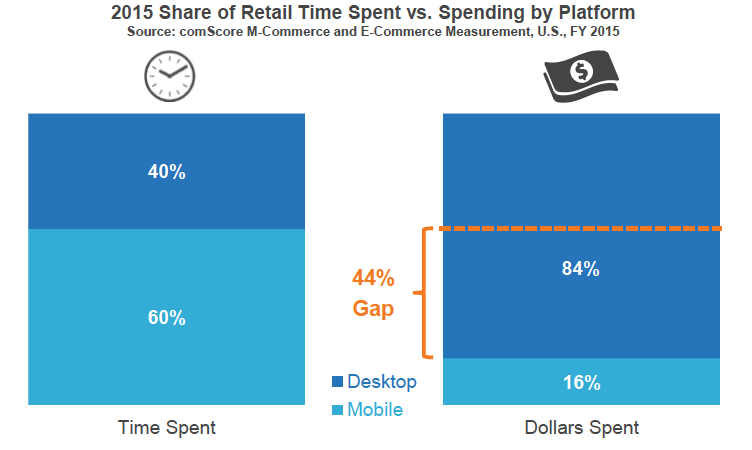Why the Mobile e-Commerce Market Should Be Larger By Now
While the mobile e-commerce market is definitely on the rise in the U.S., it should be much larger by now.
Compared to other developed countries with smaller e-commerce markets, as well as to desktop e-commerce at home, the U.S. is lagging. eMarketer estimates that in 2015, mobile e-commerce sales as a proportion of total e-commerce were as high as 33% in the U.K. and 26.3% in Germany, but just 16% in the U.S. Considering that 79% of U.S. mobile users now own smartphones (and that many of those phones now have larger screen sizes), and with more retailers optimizing their online stores for mobile, you would think there would be a big jump in transactions happening over mobile devices in the country.
Mobile E-Commerce Growth Requires Shifting Time To Dollars
It’s not that mobile usage in the U.S. is low compared to desktop. Recent data show that though U.S. shoppers spend a lot of time on mobile sites, that time isn’t translating into transactions. comScore, the media measurement and analytics company, noted this earlier in their report Cross-Platform Future in Focus 2016:

Source: comScore
In other words, if more of the time mobile users spend on their phone could include transactions, the total e-commerce market would be much larger, and more dollars would flow to the merchants becoming increasingly dependent upon online sales for growth and survival.
So how can U.S. merchants convert more mobile minutes to dollars?
Make Sure To Invest In Optimizing Mobile Shopping Experiences
One place to start is to conduct user research on how your target customer segments currently use different types of mobile devices, in order to determine differences in search and navigation patterns. At a recent gathering of ATG users in Boston, I heard one e-commerce director describe the difference between how he sees customers shopping on mobile: a tablet is more of a passive, lean-back device more conducive to browsing, while a smartphone is more for targeted “spearfishing”, where the object for purchase is already well-defined and just requires narrowing down a few choices. His point was that simply optimizing for mobile and desktop is not enough: you have to optimize for tablets and smartphones separately, since they both offer different shopping experiences.
Another issue to consider is whether you need to improve your mobile website performance. Heading into the 2016 holiday shopping season, retailers need to ensure that they will be able to handle the surges in traffic that will occur, and that things like page load times do not increase or that sites go down altogether. Luxury retailer Neiman Marcus learned this the hard way last year when its site failed on Black Friday, as did Target’s site the following Cyber Monday. And part of optimizing this performance is the importance of the marketing team to keep the e-commerce team informed about timing and details of campaigns that will affect site traffic, so that those managing performance can watch for spikes and traffic problems and resolve them as early as possible.
A third area to examine is whether you are offering the right payment options for your target market. If you are only selling within the U.S., it is pretty standard to offer a selection of credit cards and online payment options like PayPal. But if you are also targeting buyers in other countries, you’ll need to make sure you are offering local payment options customers in those regions prefer, like direct debit or payment providers specific to their countries such as Alipay in China or Braspag in Brazil.
These steps are all part of shifting the mindset about your customers from thinking not just about who they are, but what they want to do (my colleague Tim Walters wrote about this in more detail earlier this week here) . Yes, personas and demographics are important, but so are understanding what customers are trying to achieve, and what makes up the journeys that they are taking with these achievements in mind. Better understanding of your customers’ expectations and actions around mobile experiences will be key to improving mobile e-commerce conversions.
For more information about mobile e-commerce optimization and other ways you need to prepare for the holiday retail season, contact us, or download our new paper Preparing for the Holiday Retail Season: The Amazon Threat and the Facebook Trap.(registration required).








